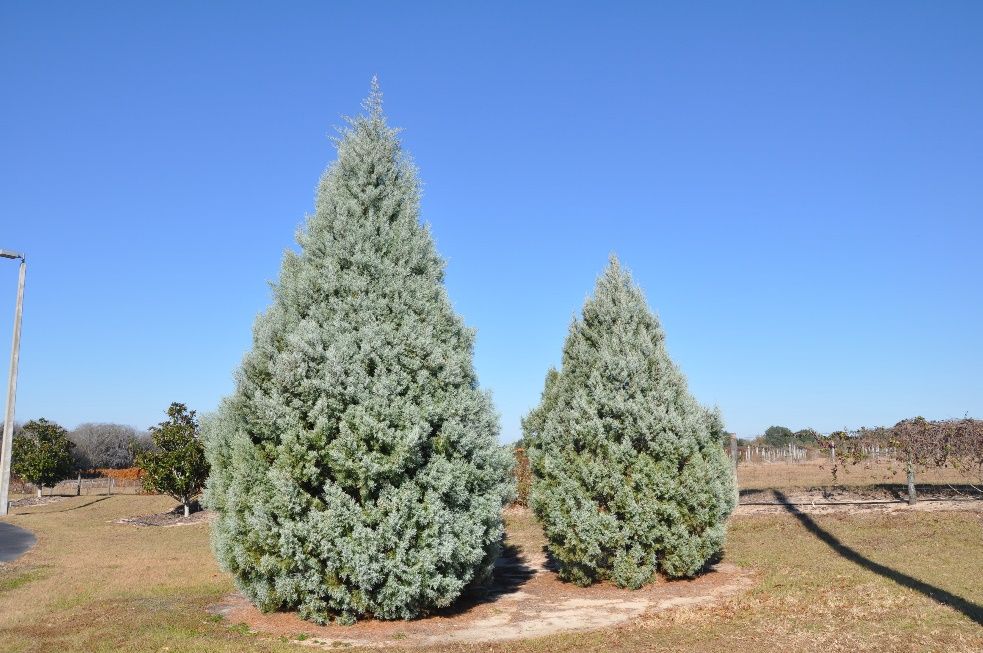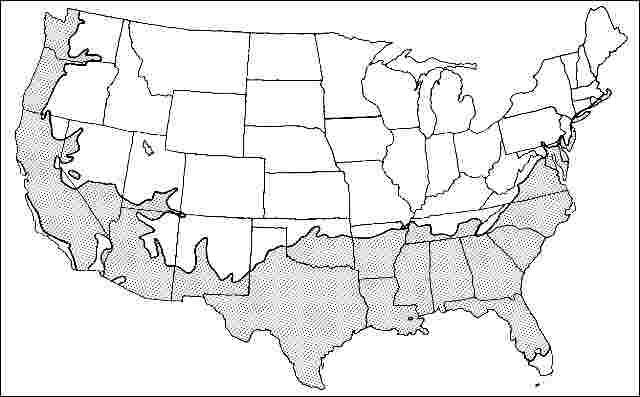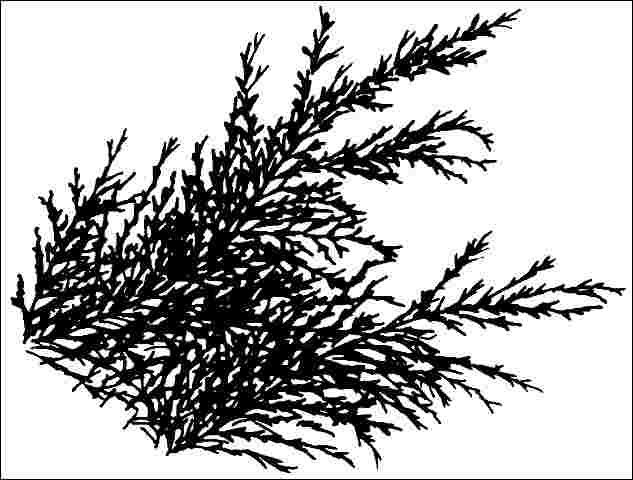Introduction
This rapidly-growing North American native evergreen reaches 30 to 40 feet in height with a 15- to 25-foot-spread. It is referred to as Cupressus glabra or Cupressus arizonica var. arizonica by some botanists. The green foliage has a silver/gray shimmer and the branches are more open than most other species of juniper. The inconspicuous flowers are followed by small, 1-inch cones which persist on the tree. The peeling brown bark becomes gray with age. Arizona cypress is often used as a specimen or windbreak planting and is a common sight in west Texas and the southern High Plains where it tolerates the hot, dry conditions with ease.

Credit: Stephen Brown, UF/IFAS
General Information
Scientific name: Hesperocyparis arizonica var. arizonica
Pronunciation: hes-per-oh-SY-pair-iss air-ih-ZAWN-ih-kuh variety air-ih-ZAWN-ih-kuh
Common name(s): Arizona cypress
Family: Cupressaceae
USDA hardiness zones: 7A through 11 (Figure 2)
Origin: native to North America
Invasive potential: not assessed/incomplete assessment
Uses: specimen; screen

Credit:
Description
Height: 30 to 40 feet
Spread: 15 to 25 feet
Crown uniformity: symmetrical
Crown shape: columnar, pyramidal
Crown density: dense
Growth rate: moderate
Texture: fine
Foliage
Leaf arrangement: opposite/subopposite (Figure 3)
Leaf type: simple
Leaf margin: entire
Leaf shape: scale-like
Leaf venation: none, or difficult to see
Leaf type and persistence: evergreen
Leaf blade length: less than 2 inches
Leaf color: green, blue or blue-green
Fall color: no color change
Fall characteristic: not showy

Credit:
Flower
Flower color: yellow
Flower characteristics: not showy
Fruit
Fruit shape: round
Fruit length: 0.5 to 1 inch
Fruit covering: dry or hard
Fruit color: brown
Fruit characteristics: does not attract wildlife; not showy; fruit/leaves not a litter problem
Trunk and Branches
Trunk/bark/branches: branches don't droop; showy; typically one trunk; thorns
Pruning requirement: little required
Breakage: susceptible to breakage
Current year twig color: green
Current year twig thickness: thin
Wood specific gravity: unknown
Culture
Light requirement: full sun
Soil tolerances: sand; loam; acidic; alkaline; well-drained
Drought tolerance: high
Aerosol salt tolerance: unknown
Other
Roots: not a problem
Winter interest: no
Outstanding tree: no
Ozone sensitivity: unknown
Verticillium wilt susceptibility: resistant
Pest resistance: sensitive to pests/diseases
Use and Management
It can be found growing with a single trunk or in clumps. It is probably best used in landscapes which are not irrigated since it is susceptible to juniper blight. Many locations in the eastern part of the country are too humid to successfully grow this tree. It is most often found in the west and in the drier parts of Texas and Oklahoma.
Roughbark Arizona cypress should be grown in full sun on well-drained soil. Although it will tolerate clay soil, the shallow roots will not gain as secure an anchor as they might in other soils and the tree may, as a result, topple over during wind and rainstorms.
Cultivars include: 'Compacta'—low, conical; 'Gareei'—silver-blue foliage; 'Glauca'—leaves silvery-grey; 'Greenwood'—medium silver/grey/green; 'Oblonga'—horizontal branches, producing oblong effect, leaves grey/green; 'Verhalenii'—leaves bright glaucous-blue, softer and more graceful than wild forms; 'Watersii'—narrowly pyramidal, compact.
Propagation is by seed or grafting.
Pests
Bagworms.
Diseases
Juniper blight, especially in cool, humid regions.
A stem canker has devastated large numbers of trees in various parts of the country.